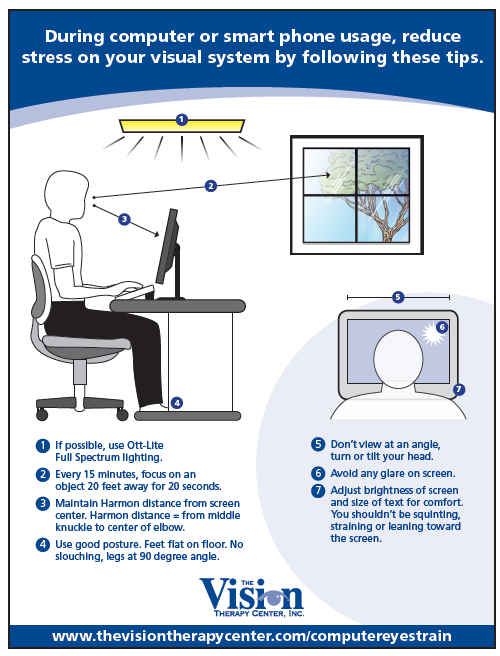
Remember the notion that you got reading glasses when you started getting old? Get ready for a paradigm shift: These days you’re going to start needing computer eyestrain glasses -- and you’re going to need them at an increasingly younger age.
This 21st century concept became painfully (literally) clear to Dr. Brandon Begotka, a developmental optometrist at The Vision Therapy Center.
Dr. Begotka noticed that after a long day working on the computer and checking patient charts, he was becoming fatigued. “I was starting to notice eyestrain during the end of the day,” he said.
He knew he wasn’t suffering any significant vision problems. Words were not looking blurry, and he was not experiencing significant headaches. But the fatigue was troublesome, so as a preventative measure, he decided to have a Functional Vision Test.
Dr. Begotka’s concern was that he was experiencing computer eyestrain, or Computer Vision Syndrome (CVS). CVS is eyestrain that results from near work on the computer. It can lead to headaches, sore eyes, blurry vision, fatigue and potentially even myopia (near-sightedness) among students.
The impact of CVS is just starting to become apparent. A recent story in Time.com reported that up to 90% of young adults in Major Eastern countries suffer from myopia, or nearsightedness. The main culprits are suspected to be an overload of near work and a lack of sunlight.
Similar trends are underway in the United States. A Roper Starch Survey indicated the average American child now spends one to three hours per day on the computer. For adults, the number is somewhere in the four to six hour range.
Dr. Begotka knew he wasn’t immune to the problem, but he also knew that his overall vision was fine. “I’ve never worn glasses, and I can see clearly,” he said.
But a Functional Vision Test revealed a different issue.
A Slight Vision Problem Can Cause a Big Headache
The testing indicated a very slight problem. Normally, both eyes focus at a certain point, such as the computer screen. The point where Dr. Begotka’s eyes were focusing was just short of the screen, a very slight distance that was causing his eyes to strain to see the screen.
Think of a steering wheel in a car that’s just a few inches too far away; unless you adjust your seat, your arms will begin to tire after a while. The same thing happened to Dr. Begotka.
Fortunately, as a developmental optometrist and an expert in prescribing glasses, he knew there was a solution. After being examined by his colleague, Dr. Kellye Knueppel, he ordered a pair of glasses.
“I prescribe these kinds of lenses every day, so I understand their power, and how they can make a really big change,” she said.
Dr. Begotka stressed that the glasses did not have the typical effect people think of when they consider reading glasses, for example. “I see clearly with or without the glasses,” he said. “It just makes things more comfortable.”
This “comfortable” feeling occurs because the right lenses will help shift an image to place where you’re more comfortable seeing, which is becoming an increasingly relevant issue these days.
“There is a stigma with reading glasses,” he said, “that might have applied sixty years ago when people didn’t do much computer work. But now we’re working with things in a different visual space. Smart phones, iPads, laptops - it’s all near work. Our perception of these kinds of visual aids need to change. Reading glasses are not just for an older population anymore.”
Since he’s begun using the new glasses, Dr. Begotka has noticed a significant improvement. “Now I don’t experience eyestrain at all,” he said, noting the fatigue has diminished. “I can work longer overall, and more comfortably.”
Dr. Begotka believes the glasses can be preventative, warding off the types of problems that are affecting the Asian schoolchildren mentioned earlier in the article. “I found a prescription for her to use, and she uses them anytime she does near work,” he said.
This could just be the tip of the iceberg. “Computer vision syndrome is out there,” he said. “It’s something that we know is happening. We see two- and three-year-olds playing with smart phones. We’ve got to think about this as not only a current issue, but one that’s going to become more pervasive, and at a younger age, as our computer usage increases.”
 Download a free poster detailing how to avoid computer eyestrain (Computer Vision Syndrome).
Download a free poster detailing how to avoid computer eyestrain (Computer Vision Syndrome).
